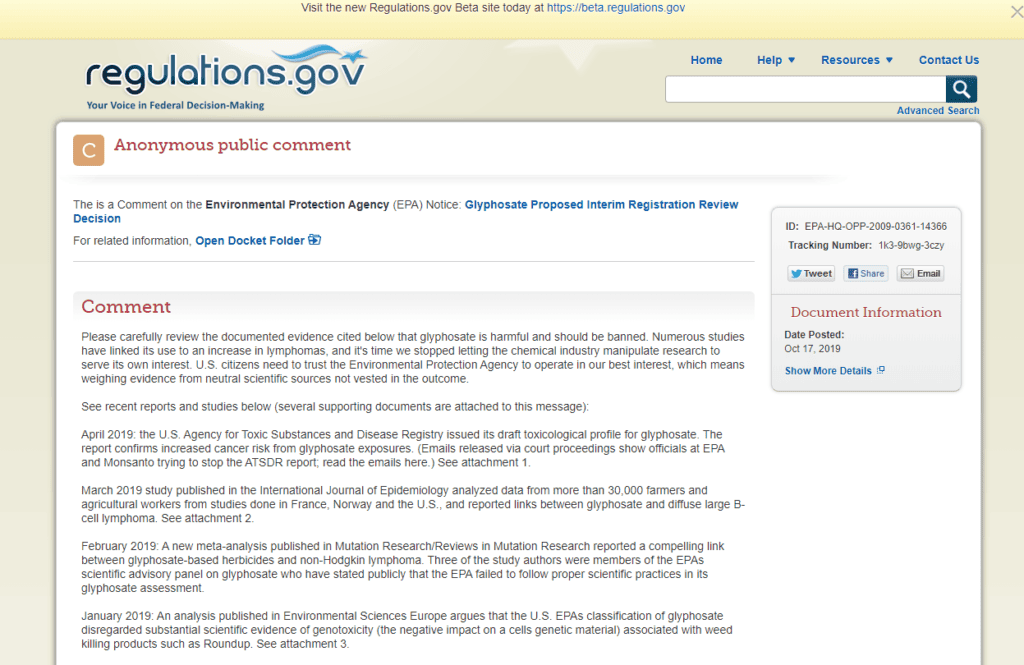(Update with EPA explanation)
In an unusual move, the Environmental Protection Agency (EPA) has deleted the name of a high-ranking U.S. health official from a public comment that warned of cancer links to the weed killing chemical glyphosate and called for a halt to industry manipulation of research.
The public comment in question was submitted to the EPA and posted on the agency’s website under the name of Patrick Breysse, the director of the National Center for Environmental Health and the Agency for Toxic Substances and Disease Registry (ATSDR). TheATSDR is part of the U.S. Department of Health and Human Services.
The comment under Breysse’s name was filed last year with the EPA in response to an updated agency review of glyphosate and urged the agency to review “documented evidence” that glyphosate was harmful and should be banned.
For months the comment sat on the EPA website under Breysse’s name. It was only after U.S. Right to Know sought commentary last week from Breysse about his statement that the EPA removed his name. The comment now is attributed to “Anonymous,” after Breysse’s employer determined it was not actually submitted by him, according to the EPA.
Glyphosate is the active ingredient in Roundup and other herbicides and was popularized by Monsanto, a unit of Bayer AG. It is considered the most widely used herbicide in the world. It is also one of the most controversial and is the subject of lawsuits brought by tens of thousands of people who claim they developed cancer because of exposure to Roundup and other glyphosate herbicides made by Monsanto.
The EPA has steadfastly defended the safety of glyphosate despite findings by many independent scientists that glyphosate herbicides can cause a range of illness and disease, including non-Hodgkin lymphoma.
The comment under Breysse’s name contradicted the EPA’s position:
“Numerous studies have linked its use to an increase in lymphomas, and it’s time we stopped letting the chemical industry manipulate research to serve its own interest. U.S. citizens need to trust the Environmental Protection Agency to operate in our best interest, which means weighing evidence from neutral scientific sources not vested in the outcome.”
Notably, Breysse is also the ATSDR official who was pressured by EPA officials in 2015 at the behest of Monsanto to put a halt to a review of glyphosate toxicity then just getting underway at the ATSDR. The push to delay the ATSDR review of glyphosate came because Monsanto feared the ATSDR would agree with the International Agency for Research on Cancer (IARC) in finding cancer links to glyphosate, internal Monsanto correspondence shows.
One internal Monsanto email said EPA official Jess Rowland told Monsanto he should “get a medal” if he was successful in killing the ATSDR glyphosate review.
The ATSDR review was in fact delayed until 2019 after the pressure from Monsanto and EPA officials. When the report was finally released, it did confirm Monsanto’s fears, lending support to the 2015 IARC concerns about links between cancer and glyphosate. The ATSDR report was signed by Breysse.
When asked about the change in attribution to the public comment, the EPA said it removed Breysse’s name after the Centers for Disease Control and Prevention, which oversees ATSDR, told EPA the comment was not submitted by Breysse and asked that it be deleted or edited. Rather than delete the comment, EPA elected to keep the comment in the docket but changed the submitter’s name to “anonymous.”
The EPA said it does not screen or authenticate comments submitted.
The press office for the National Center for Environmental Health also said Breysse did not submit the comment in question. Breysse did not respond to a request to confirm or deny his authorship of the comment on the EPA website.
The original comment and the changed one are shown below:










